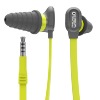atblis
Member
Saw these in Home Depot and thought they might be interesting for shooting. NRR of 30 dB which should sufficient. The cell phone app sounds interesting.
https://www.ryobitools.com/power-tools/products/details/651

Eliminate noise and protect your hearing with more functionality than ever before. With RYOBI Phone Works mobile app and Noise Suppression Earphones, you get the protection of jobsite earplugs plus the convenience and functionality of noise cancelling headphones. Using the free mobile app, the OSHA- compliant earphones connect to your smartphone, where sounds are measured and can be recorded. The innovative app allows you to selectively block noises up to 82 decibels and amplify sounds you need to hear- such as conversations and alerts. The set includes a microphone, so you can make phone calls and record sound even in noisy environments. All of these functions are controlled from your smartphone screen for easy, adjustable control over noise. Take care of your ears the smart way with RYOBI Phone Works Noise Suppression Earphones and mobile app. RYOBI Phone Works – Transform your phone into your smartest tool.
https://www.ryobitools.com/power-tools/products/details/651

Eliminate noise and protect your hearing with more functionality than ever before. With RYOBI Phone Works mobile app and Noise Suppression Earphones, you get the protection of jobsite earplugs plus the convenience and functionality of noise cancelling headphones. Using the free mobile app, the OSHA- compliant earphones connect to your smartphone, where sounds are measured and can be recorded. The innovative app allows you to selectively block noises up to 82 decibels and amplify sounds you need to hear- such as conversations and alerts. The set includes a microphone, so you can make phone calls and record sound even in noisy environments. All of these functions are controlled from your smartphone screen for easy, adjustable control over noise. Take care of your ears the smart way with RYOBI Phone Works Noise Suppression Earphones and mobile app. RYOBI Phone Works – Transform your phone into your smartest tool.

